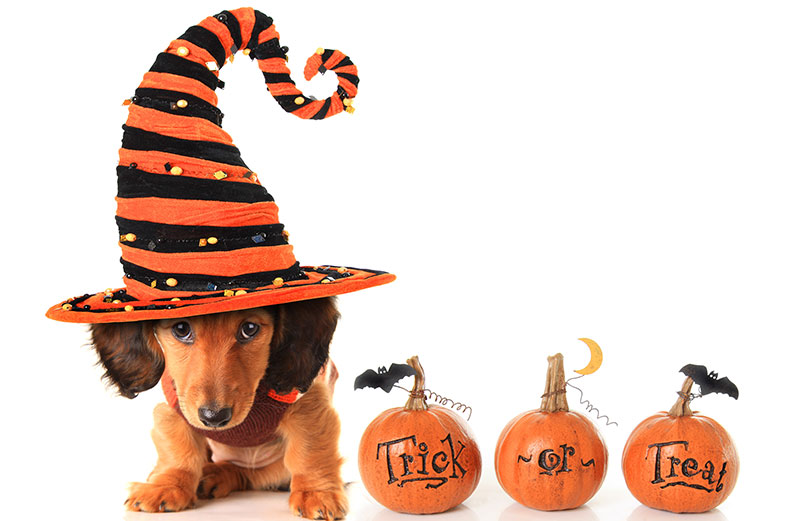Top 10 Halloween Safety Tips for Pet Parents From the Ghosts and Goblins at Portsmouth Veterinary Clinic
Are you getting ready for Halloween? Here are some thrill and chill tips from the staff at Portsmouth Veterinary Clinic to keep your pets safe this Halloween.
1. That bowl of candy is for trick-or-treaters, not for your pets. Chocolate in all forms—especially dark or baking chocolate—can be very dangerous for dogs and cats. Candies containing the artificial sweetener xylitol can also cause problems. If you want your pets to participate in trick and treat, give your pets their normal treats or pet safe goodies.
2. Please be sure your pet is microchipped. If for any reason your pet escapes during Halloween and becomes lost, a microchip (along with a collar and tags) can be a lifesaver, increasing the chances that he or she will be returned to you.
3. Please have a safe place ready for all pets during trick-or-treat hours. Strangers in scary Halloween costumes—who ring the doorbell too!– can distress any pet and even make some of the friendliest animals become more aggressive.
4. When opening the door for trick-or-treaters, take care that your cat or dog doesn’t dart outside.
5. The constant sounds of door knocking and door-bell ringing can stress pets too. Sometimes, dogs and cats can experience stress-related diarrhea or appear visibly scared and anxious. If your pet is showing any sign of distress, please move them to a quiet place during the trick-or-treating hours.
6. Popular Halloween plants such as pumpkins and decorative corn are considered to be relatively nontoxic, but they can produce stomach upset in pets who nibble on them.
7. Exercise caution if you add a candle to your carved pumpkin. Pets can easily knock a lit pumpkin over and cause a fire or get burned.
8. Dressing up your pet? Go slowly to be sure that your pets like to be dressed. They may prefer their birthday suit. Your best costume option may be a Halloween scarf. Be sure to try on costumes before the big night and practice with positive rewards so that your pets like being dressed up.
9. Make sure any costume, hat, wig or scarf does not constrict your pets; movement or hearing, or impede his ability to breathe, bark or meow. Also,
10. Take a closer look at your pet’s costume and make sure it does not have small, dangling or easily chewed-off pieces that could be a choking hazard and be sure your pet’s costume is a good fit. Ill-fitting outfits can get twisted on external objects or your pet, leading to injury.
11. Keep your pets indoors on Halloween night, especially black cats. Animals are at risk for cruel treatment by some Halloween pranksters.
Candy Concerns
Candies, gums, mints, baked goods and chocolate containing the “sugar free” sweetener xylitol are especially poisonous, causing rapid hypoglycemia (low blood sugar) and liver failure in dogs and possibly other species (ferrets).
Chocolate is toxic to pets. A 50 pound dog would have to eat about 50 ounces of milk chocolate (but only 5 ounces of baking chocolate) for a toxic dose, but much smaller amounts can cause vomiting and diarrhea.
Signs of chocolate toxicity include
● Tremors
● Nervousness
● Vomiting
● Diarrhea
● Increased heart rate
● Seizures and death in severe cases
If you suspect that your pet has eaten chocolate, please call us as soon as possible..
Other candies, such as lollipops and those with plastic components, pose a danger if ingested. Lollipop sticks and plastic parts can cause intestinal obstruction and potentially rupture the intestines, which is a life-threatening emergency.
By taking these few precautions, you can ensure that everyone will have a happy Halloween, including your pets. If you do celebrate Halloween with your pet, please post a photo on our Facebook page!
If your pet seems to be experiencing any kind of emergency, please call us right away.
Happy Halloween from all of us at Portsmouth Veterinary Clinic.


